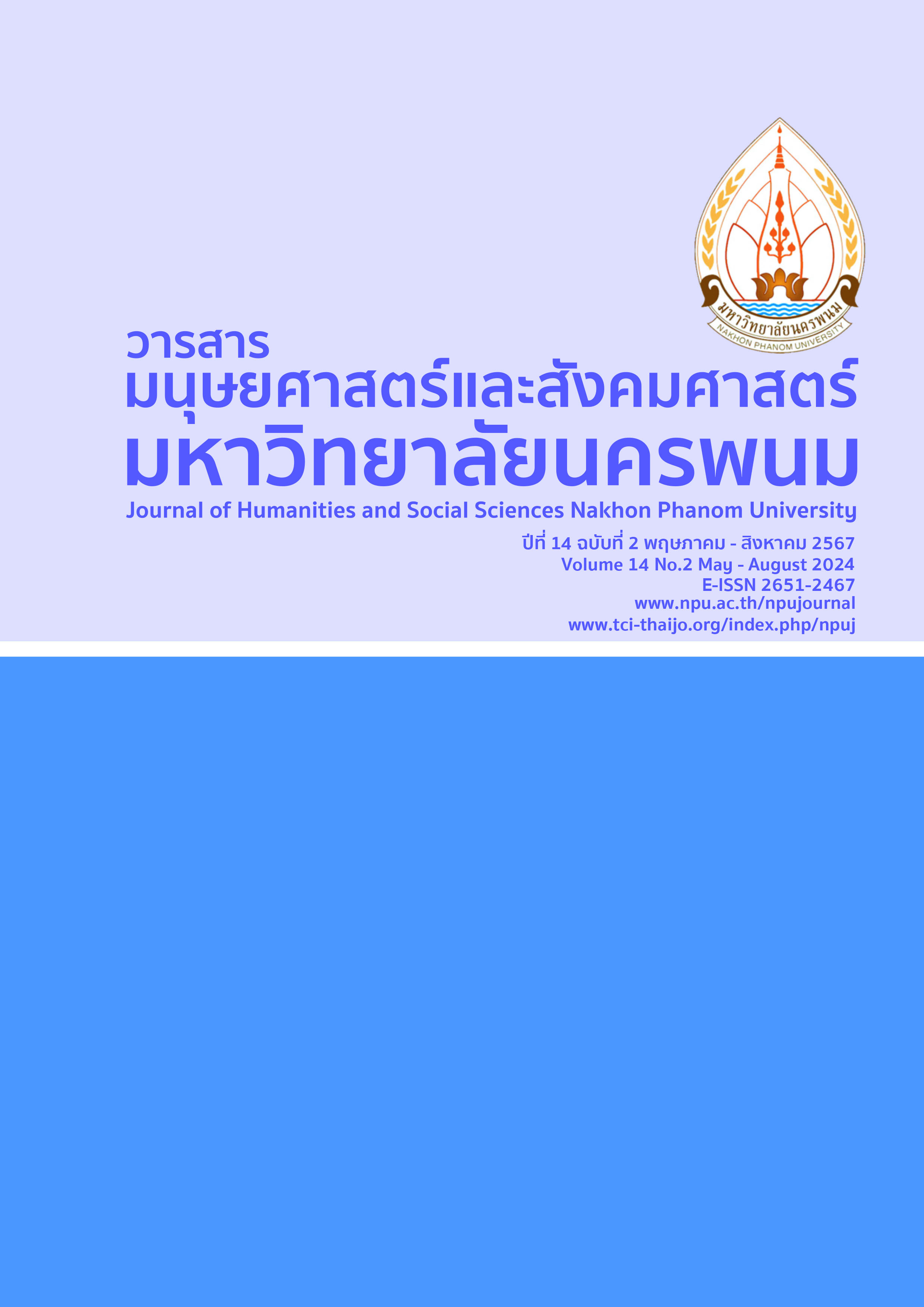The Study of Tourism Business Competitiveness of Mekong Ethnic Groups
Main Article Content
Abstract
This research aims to determine the target tourism business sectors of the Mekong ethnic groups that have the potential to develop and study the competitiveness of the target tourism business sectors of the Mekong ethnic groups. Four provinces of the Northeast region including Loei, Nong Khai, Nakhon Phanom, and Mukdahan are the areas of the study that have eight Mekong ethnic groups: Phuthai, Tai Dam, Tai Puan, Tai Yo, Phu Thai, Tai Saek, Tai Kha or Bru, Tai So, and Tai Kaleng. This survey research collected data from 3,035 residents in the community and related. A questionnaire was used as a research tool. The statistics used for data analysis include mean, standard deviation, multiple correlation analysis, and multiple regression analysis. The results indicate that 1) the Mekong ethnic groups of Phuthai and Tai Dam are most capable of housing or homestay business sector, while the Tai Phuan, Tai So, Tai Yo, Tai Kha or Bru and Tai Kaleng ethnic groups have outstanding competitiveness in the tourism business in the souvenir business sector. As for the Tai Saek ethnic group, food and beverage business is most notable in its potential; 2) the competitiveness of ethnic groups in the Mekong Basin in the tourism business is at a moderate level; 3) the factors of production, demand condition, readiness in business competitiveness and strategies, government policy, and other related factors positively affect the success of the community from tourism business development in Mekong ethnic groups. The researcher has suggested guidelines for developing and enhancing the competitiveness of the Mekong ethnic group tourism business by classifying the appropriate groups according to their different potential and outstanding.
Article Details

This work is licensed under a Creative Commons Attribution-NonCommercial-NoDerivatives 4.0 International License.
References
ASEAN Secretariat. (2024). ASEAN tourism strategic plan 2016-2025. Retrieved February 2024, from https:// secretary.mots.go.th/ewtadmin/ewt/secretary/download/article/article_20240216150147.pdf
Bangkok Post (2024). Thailand falls by more than 10 places in tourism ranking. Retrieved May 2024, from https://www.bangkokpost.com/business/general/2800278/thailand-falls-by-more-than-10-places-in-tourism-ranking
Chumpa, N. & Kaewpia, T. (2020). The driving of the tourism management based on the social capital of ethnic communities in Maesalong-Nok sub-district, Mafahluang district, Chiang Rai province. Journal of Social Sciences Srinakharinwirot University, 23(1),20-38.
Department of Provincial Administration. (2019). Statistical data structure of population numbers. Retrieved January 2024, from https://stat.bora.dopa.go.th/new_stat/webPage/statByAge.php
DASTA (Designated Areas for Sustainable Tourism Administration) (2019). Thai Yo Ban Phon. Retrieved January 2024, from https://cbtthailand.dasta.or.th/webapp/reviewTravel/content/10/
DASTA (Designated Areas for Sustainable Tourism Administration). (2021). Tai Dam community: Cultural tourism destination. Retrieved January 2024, from https://www.dasta.or.th/th/article/376.
Fernando, I. N. (2021). Tourism Amid Covid-19 Pandemic in Sri Lanka Way-Forwarding Strategies Through the Porters’ Diamond Model. Retrieved January 2024, from https://diglib.natlib.lk/bitstream /handle/123456789/40140/Fernando% 2C%20Imali %20N..pdf?sequence=1&isAllowed=y
Hair Jr., J. F., Black, W. C., Babin, B. J. & Anderson, R. F. (2010). Multivariate data analysis: A global perspective. (7th ed.). New Jersey : Pearson Prentice Hall.
Krejcie, R. V. & Morgan, D. W. (1970). Determining sample size for research activities. Educational and Psychological Measurement, 30(3),607-610.
Luo, X. (2019). Coastal tourism commodity industry cluster based on diamond model and ecological niche. Journal of Coastal Research, 94(sp1),828-832.
Ministry of Tourism and Sports. (2015). Thailand homestay standard. Bangkok : Chulalongkorn University Printing House.
Ministry of Tourism and Sports. (2021). Tai Seak. Retrieved January 2024, from http://www2.Nakhon phanom.go.th/ charm/detail/36/data.html
Ministry of Tourism and Sports (2023). Tai So. Retrieved January 2024, from http://www2.nakhonphanom. go.th/charm/ detail/37/data.html
Ministry of Tourism and Sports (2024). Tai kha. Retrieved January 2024, from http://www2.nakhonphanom. go.th/charm/ detail/40
Oanh, N. M. & Trinh, N. T. T. (2021). Progress of cooperation for sustainable development of the Greater Mekong Subregion and Vietnam’s contribution. Linguistics and Culture Review, 5(S4),2476-2490.
Ounokphan, S. (2020). Travel Attitudes and Behaviors: The Study of the Difference between Generation X and generation Y Travelers. Retrieved January 2024, from https://archive.cm.mahidol.ac.th/ bitstream/123456789/3600 /1/TP%20MM.030% 202563.pdf
Porter, M. E. (1980). Competitive advantage: Creating and sustaining superior performance; and competitive strategy: Techniques for analyzing industries and competitors. New York : Free Press.
Punwun, I. (2021). The development of the cultural tourism of sustainable ethnic group. Retrieved January 2024, from http://cmruir.cmru.ac.th/bitstream/123456789/2193/7/Cover.pdf
Sitikarn, B. (2021). Development of ethnic tourism in poverty and drug deduction (the case study of Chiangrai Province, Thailand). E3S Web of Conferences, 284,10005.
Smith, L. V. (1989). Hosts and guests: The anthropology of tourism. Pennsylvania : University of Pennsylvania Press.
Sunthornpasat. S. (2005). Ethnic relations: basic anthropological concepts in the study of ethnic group identities, nations, and the organization of ethnic relations. Bangkok : Muang Boran.
Vallibhotama, S. (2003). Isan civilization basin: Revealing archaeological evidence that redefines Thai history. (4th ed). Bangkok : Matichon.
Vetchachai, A. & Yodkamolsat, S. (2004). Social welfare: For the people: concepts, policies, and practices. Bangkok : Addison Press Products.
Wiratnipawan, W. (2008). The applied development of urban and rural areas. (2nd eds). Bangkok : Four Pace Printing House.
Xu, J., (2019). Analysis on the Tourism Competitiveness of Five Central Asian Countries Based on Diamond Model. Retrieved January 2024, from https://www.atlantis-press.com/proceedings/seiem-18/55911569
Yaowanannon, K., Supasetthasiri, P., Nopudompan, K. & Inchan, N. (2019). Thai Phuan symbols: A study of the identity of the Thai Phuan cultural group in the central region of Thailand for design guidelines. Journal of the Institute of Culture and Arts, Srinakharinwirot University, 21(1),166-185.


